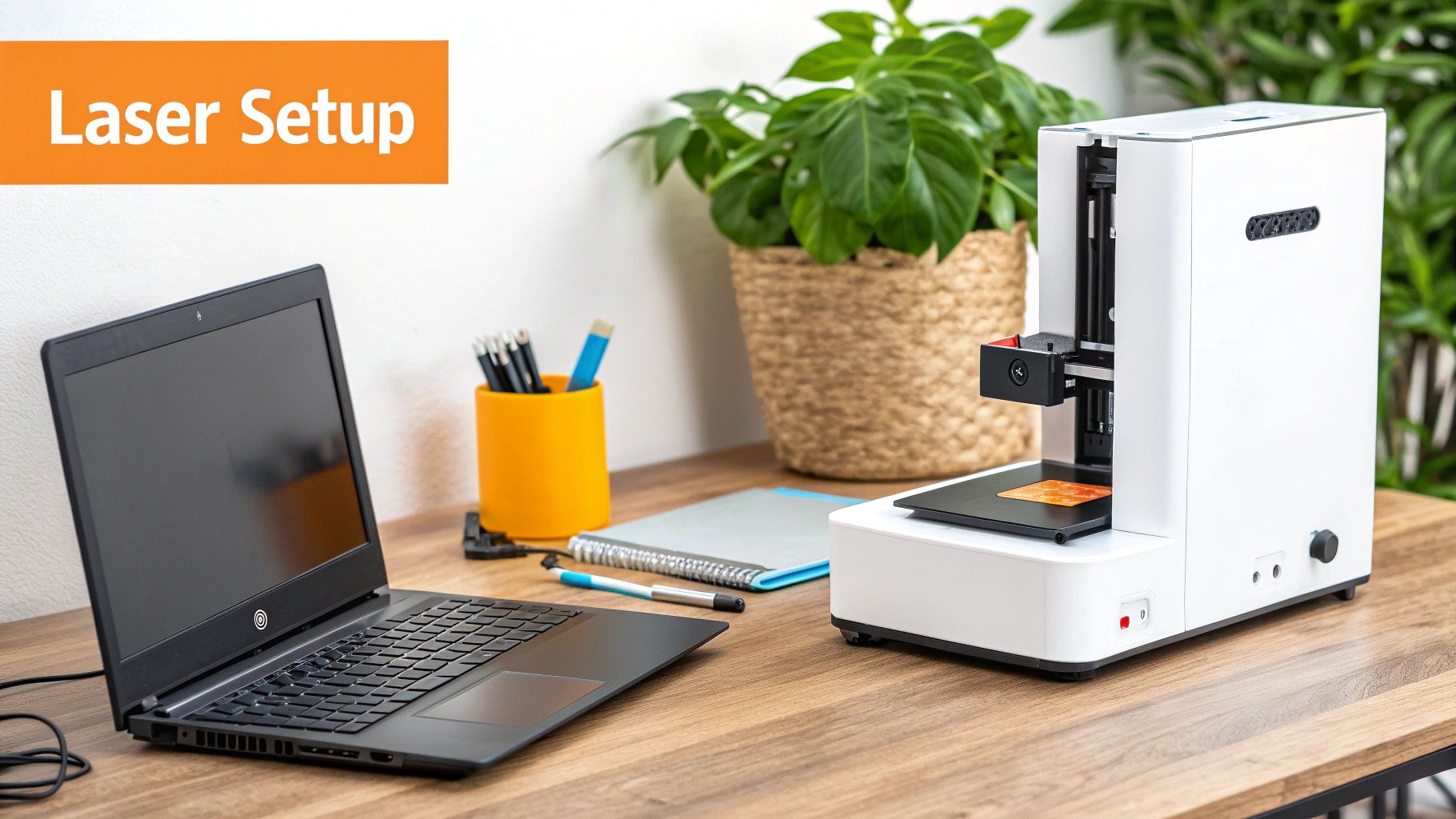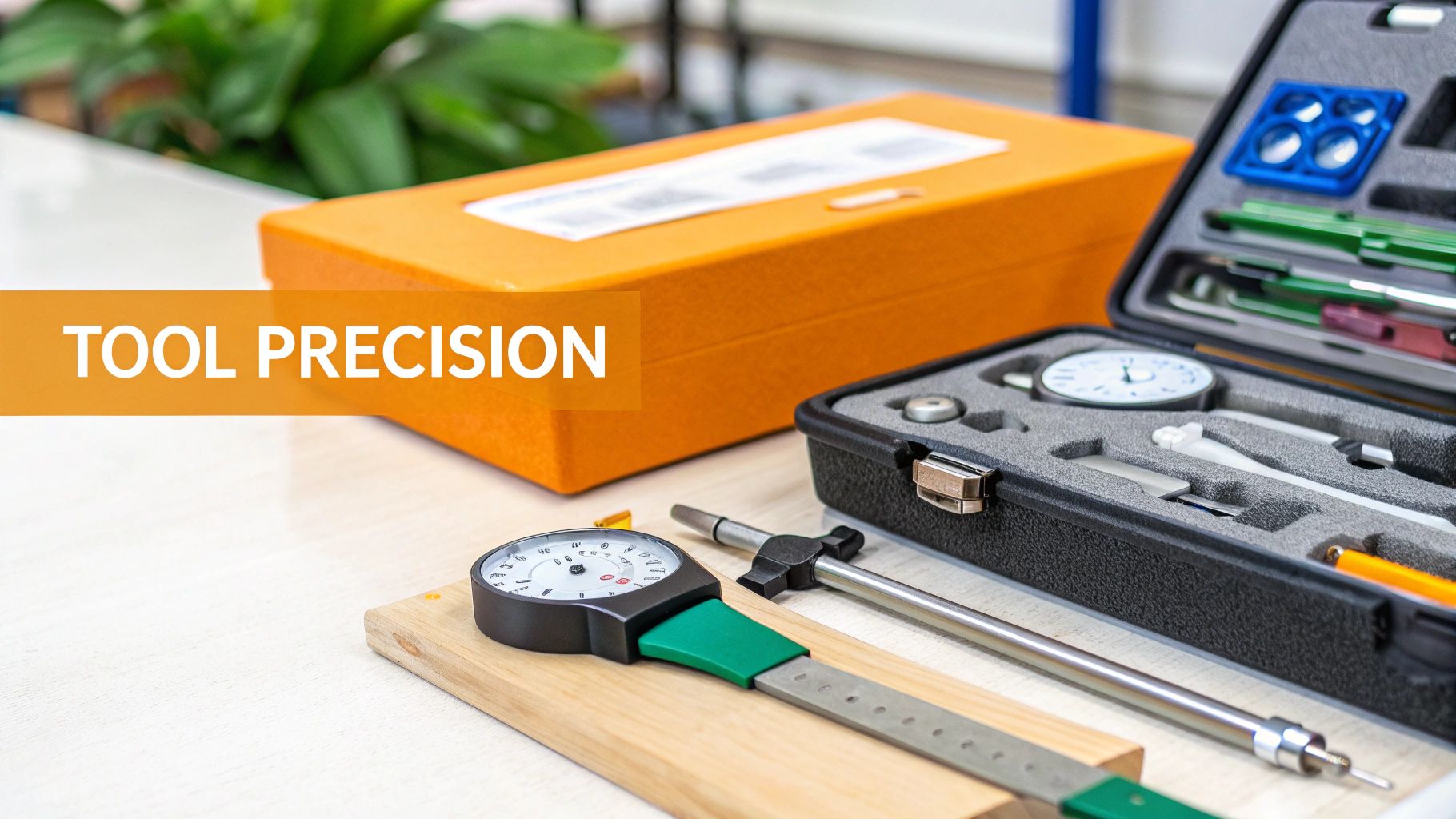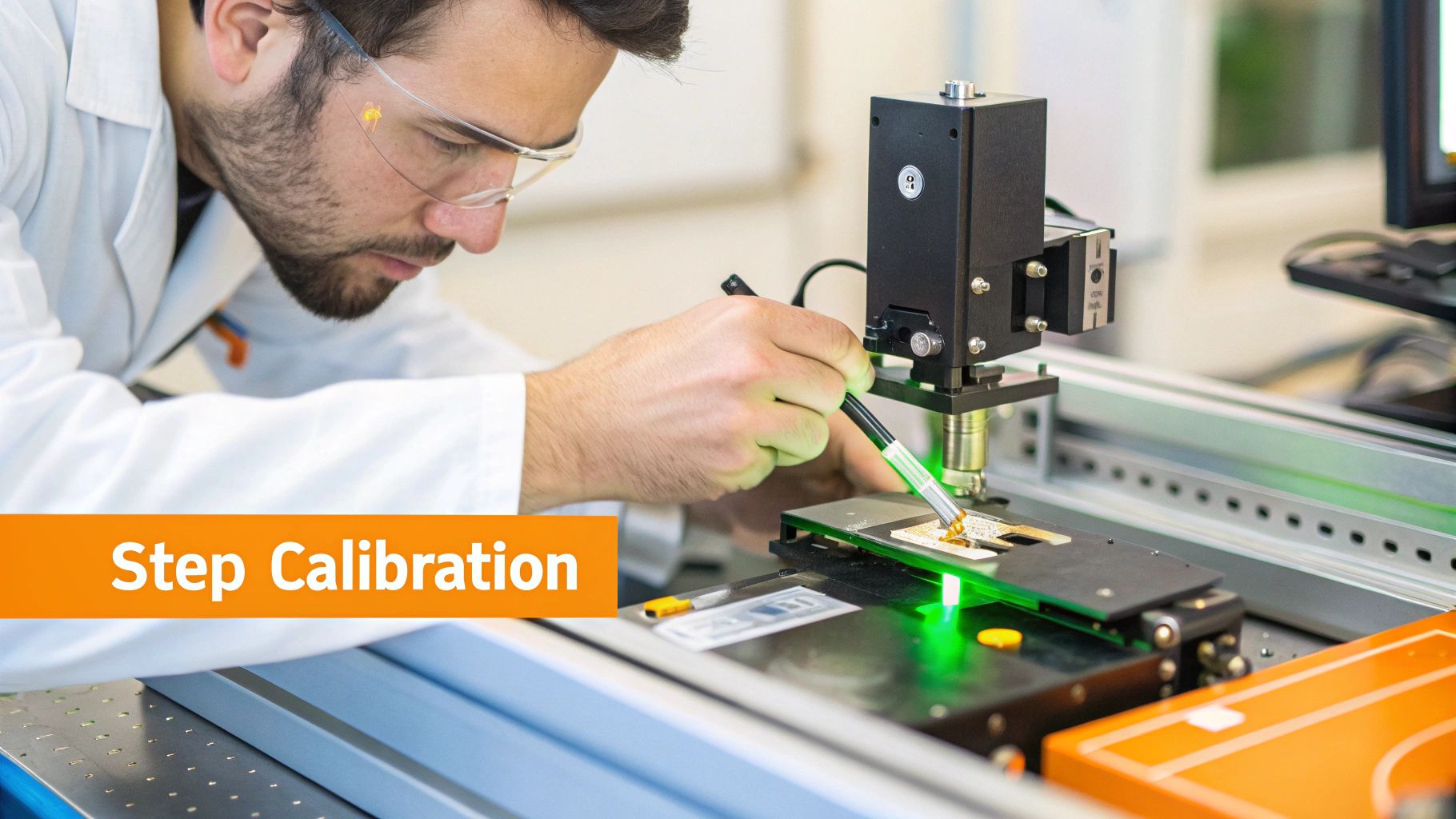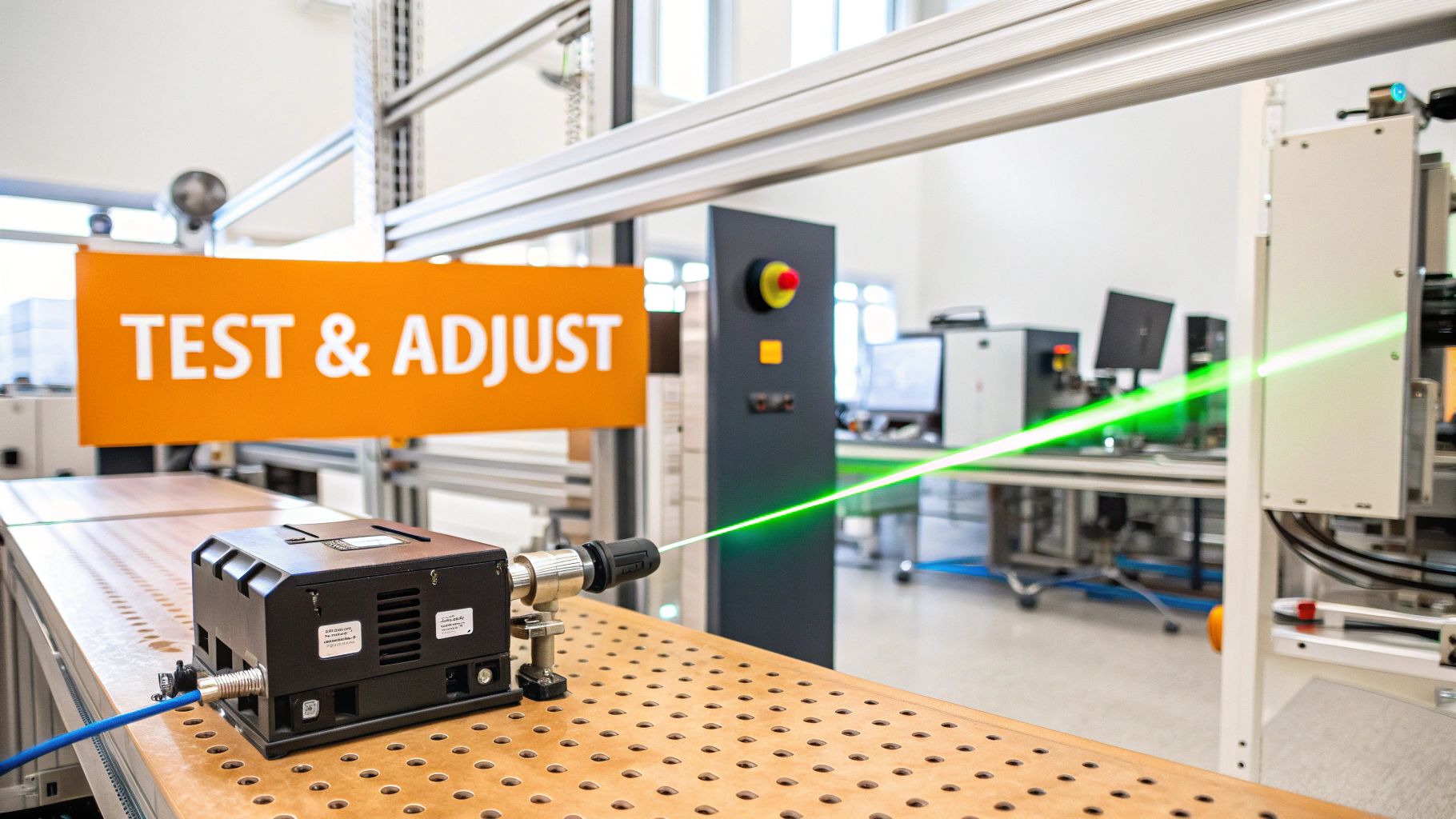שליטה ביסודות כיול לייזר

כיול לייזר הוא חיוני לשמירה על דיוק ולהארכת חיי הלייזר שלך. תהליך זה מבטיח ביצועים מקסימליים ותוצאות עקביות. ללא כיול, הלייזרים עלולים להפוך ללא מדויקים, מה שישפיע על האיכות והאמינות של העבודה שלך.
דמיין חותך לייזר שיוצר חתכים לא מדויקים בגלל כיול לקוי. זה יכול להוביל לבזבוז חומרים ולפגיעה בפרויקטים. כיול נכון מונע בעיות אלו ומבטיח שהלייזר שלך יספק תוצאות צפויות.
מדוע כיול לייזר חשוב?
לייזרים, כמו כל כלי מדויק, חווים סטייה ושינויים עקב תנודות טמפרטורה, בלאי רכיבים ורעידות. סטייה זו משפיעה על הדיוק ועלולה להוביל לטעויות יקרות ביישומים כמו חיתוך או חריטה בלייזר.
כיול קבוע עוזר לזהות בעיות פוטנציאליות בשלב מוקדם. תחזוקה מונעת זו יכולה לחסוך לך תיקונים נרחבים ויקרים יותר בעתיד. חשוב על זה כעל כיוון מחדש של הלייזר שלך, שמבטיח שהוא פועל בצורה חלקה ומונע בעיות משמעותיות.
כיול הוא קריטי בתחומים מגוונים. בייצור, הוא מבטיח דיוק בחיתוך, ריתוך וסימון. ברפואה, כיול מדויק הוא חיוני להליכים כמו ניתוח לייזר לעיניים. מדידות מדויקות הן גם בסיסיות למחקר מדעי. ללמוד כיצד לכייל לייזר הוא מיומנות חשובה ללא קשר לתעשייה שלך. למידע נוסף במאמר שלנו על כיצד לשלוט ביסודות כיול הלייזר.
הבנת ההקשר ההיסטורי של כיול לייזר
הצורך בדיוק בתחומים שונים הוביל לפיתוח תקני כיול בלייזר. ככל שטכנולוגיית הלייזר התקדמה, נהלי כיול סטנדרטיים הפכו להיות חיוניים.
לדוגמה, בשנת 1997, ASTM International קבעה את התקן ASTM E1655-97 לכיול רב-משתני בספקטרוסקופיה בתחום האינפרא-אדום והאינפרא-אדום הקרוב. תקן זה היה חיוני להבטחת עקביות ואמינות בין מכשירים ויישומים שונים. חקור נושא זה לעומק כאן.
להכיר מתי הלייזר שלך זקוק לכיול
הכרת הצורך בכיול הלייזר שלך חיונית לתחזוקה פרואקטיבית. הסימנים יכולים להיות עדינים, כמו ירידה הדרגתית בעוצמת הפלט או אי-עקביות קלה בתוצאות.
התעלמות מאותות המוקדמים הללו עלולה להוביל לבעיות גדולות יותר ותיקונים יקרים. על ידי תשומת לב לביצועי הלייזר שלך והכרת הצורך בכיול, תוכל להימנע מהפסקות עבודה. גישה פרואקטיבית זו מבטיחה דיוק וממקסמת את אורך החיים של מערכת הלייזר שלך.
בחירת ציוד הכיול הנכון

כיול מדויק של לייזר כולל יותר מהבנת השלבים בלבד; הוא דורש כלים נכונים. בחירת ציוד הכיול המתאים חיונית לקבלת מדידות אמינות ומדויקות. הבחירה המדוקדקת הזו מבטיחה שמערכת הלייזר שלך תפעל במיטבה.
שיקולים מרכזיים לבחירת ציוד
מספר גורמים משפיעים על בחירת ציוד הכיול שלך. אלה כוללים את סוג הלייזר, הספק הכוח שלו, ואת היישום המיועד. לדוגמה, לייזר תעשייתי בעל הספק גבוה זקוק לכלי כיול שונים מאשר לייזר בעל הספק נמוך המשמש במעבדה.
אורך הגל של הלייזר גם משחק תפקיד משמעותי. אורכי גל שונים מגיבים בצורה שונה עם סוגי חיישנים שונים. שימוש בציוד המותאם לאורך גל מסוים מבטיח קריאות מדויקות. זה דומה לשימוש במפתח בגודל הנכון לאום – הכלי הנכון מבטיח התאמה ותפקוד נכונים.
סוגי ציוד כיול
זמינים מגוון כלי כיול, כל אחד מתוכנן למטרות ספציפיות:
-
חיישני חום: חיישנים אלה מודדים את החום המיוצר על ידי הלייזר, והופכים אותו לקריאת עוצמה. הם עמידים ומתאימים ללייזרים בעלי עוצמה גבוהה.
-
פוטודיודות: התקנים מוליכים למחצה אלה ממירים אור לזרם חשמלי, ומספקים מדידות עוצמה רגישות, במיוחד עבור לייזרים בעלי הספק נמוך.
-
פרופילרי קרן: כלים אלה מציגים את התפלגות הקרן הלייזרית במרחב. הם מנתחים את צורתה, גודלה ועוצמתה, מידע חיוני לאופטימיזציה של ביצועי הלייזר ולהבטחת יישור מדויק.
-
מדדי הספק: מכשירים אלה מודדים ישירות את עוצמת הלייזר. הם מציעים מגוון רחב של יכולות מדידה, מה שהופך אותם לוורסטיליים עבור סוגי לייזר שונים.
כדי לעזור להמחיש את ההבדלים בין הכלים האלה, בואו נסתכל על ההשוואה הבאה:
ציוד כיול לייזר חיוני: השוואה בין כלי כיול שונים והשימושים שלהם
| סוג הציוד | הטוב ביותר עבור | טווח דיוק | עלות אופיינית | תדירות כיול |
|---|---|---|---|---|
| חיישנים תרמיים | לייזרים בעלי עוצמה גבוהה | +/- 3% | $500 - $2,000 | מדי שנה |
| פוטודיודות | לייזרים בעלי הספק נמוך | +/- 1% | $200 - $1,000 | מדי שנה |
| פרופילי קרן | ניתוח קרן | משתנה | $1,000 - $10,000 | מדי שנה |
| מדי צריכת חשמל | מדידת הספק כללית | +/- 2% | $300 - $1,500 | מדי שנה |
טבלה זו מספקת סקירה כללית. עלויות ותדירויות כיול ספציפיות יכולות להשתנות בהתאם ליצרן ולדגם. חשוב להתייעץ במפרטי היצרן למידע מפורט.
חשיבות הניתור של NIST
הבטחת הדיוק של ציוד הכיול שלך חשובה לא פחות מהכיול של הלייזר עצמו. עקיבות לסטנדרטים לאומיים היא חיונית. המכון הלאומי לסטנדרטים וטכנולוגיה (NIST) משחק תפקיד מרכזי בכיול עוצמת הלייזר. ל-NIST יש היסטוריה ארוכה בתחום זה, החל מקלורימטרים הכיול חשמליים. עד 2017, הם פיתחו מערכת מתוחכמת, בעיקר באורכי גל של 1.06 מיקרון ו-10.6 מיקרון, באמצעות מערכת מדידה עם גלגל חותך רפלקטיבי. העקיבות הזו מאשרת שהמדידות תואמות לסטנדרטים הלאומיים, ומבטיחה דיוק ואמינות.
יצירת סביבת עבודה לכיול יעילה
אפילו עם ציוד מתאים, גורמים סביבתיים יכולים להשפיע על דיוק הכיול. הקמת סביבת עבודה מתאימה היא חיונית. לא תמיד נדרשת סביבת מעבדה מקצועית, אך חשוב למזער הפרעות.
שקול אלמנטים כמו יציבות טמפרטורה, זרימת אוויר, ו-אור סביבתי. גורמים אלה יכולים להשפיע על קריאות החיישן ולהשפיע על דיוק הכיול. לדוגמה, שינויים בטמפרטורה יכולים להשפיע על הרגישות של חיישני חום, מה שעלול להוביל למדידות כוח שגויות. שליטה במשתנים סביבתיים אלה מבטיחה תוצאות כיול אמינות. התייחסות לשיקולים אלה מאפשרת כיול לייזר מדויק ועקבי, אפילו מחוץ לסביבת מעבדה ייעודית.
תהליך הכיול: מההגדרה ועד האימות

כיול מדויק של לייזר דורש תהליך שיטתי, מההגדרה הראשונית ועד לבדיקות הסופיות. זה מבטיח דיוק ושומר על ביצועי הלייזר. זה כמו לעקוב אחרי מתכון מדויק, כאשר כל שלב תורם לתוצאה הרצויה.
מתכוננים לכיול
הבטיחות היא העדיפות הראשונה. תמיד יש ללבוש משקפי מגן לייזר מתאימים כדי להגן על עיניך. זה חיוני לסביבת עבודה בטוחה.
לאחר מכן, אסוף את הציוד הנדרש. תזדקק למד כוח או חיישן המתאים ללייזר שלך, יחד עם כל כלי יישור. הכנת הכלים הנכונים מראש תייעל את התהליך.
לבסוף, צור סביבה יציבה. הפחת רעידות ושלוט בתאורה הסביבתית, שכן אלה יכולים להשפיע על המדידות. רעידות עלולות לגרום לקריאות לא יציבות, ותאורה סביבתית עלולה להפריע לדיוק החיישן.
קביעת מדידות בסיס
השלב הראשון הוא לקבוע מדידות בסיס. מדוד את עוצמת הפלט של הלייזר ללא כל התאמות. קריאה ראשונית זו משמשת כנקודת ההתחלה שלך.
רשום בקפידה את מדידות הבסיס הללו. תיעוד זה חיוני למעקב אחר שינויים ולאימות יעילות הכיול. רשומות מדויקות הן המפתח לבקרת איכות ופתרון בעיות.
ביצוע התאמות מדויקות
לאחר ביצוע מדידות בסיס, כוונן את הלייזר בזהירות. בדרך כלל זה כולל כוונון הספק הפלט או היישור של הלייזר כדי לעמוד במפרטים הרצויים.
בצע התאמות קטנות והדרגתיות. שינויים גדולים ופתאומיים עלולים לגרום לחוסר יציבות ולכיול לא מדויק. תחשוב על זה כמו כיוון כלי נגינה – התאמות קטנות מביאות אותו להרמוניה.
מאמתים את הכיול
לאחר ביצוע ההתאמות, אמת את הכיול. קח מדידות חדשות והשווה אותן למפרטים ולקריאות הבסיס הראשוניות.
שלב האימות הזה מאשר שהלייזר מכויל כראוי. הוא מבטיח שהלייזר פועל בתוך הפרמטרים הנדרשים, ומספק ביצועים מדויקים ואמינים. תיעוד המדידות הסופיות הללו חיוני לבקרת איכות ומעקב. עבור לייזרים בגל רציף, יציבות ההספק לאורך זמן היא מדד אימות מרכזי. עבור לייזרים בפולסים, פרמטרים כמו רוחב הפולס וקצב החזרה הם גם קריטיים. למדו עוד במאמר שלנו על איך לשלוט בטכניקות כיוונון לייזר. זה עוזר להבטיח כיול מקיף לסוגי לייזר שונים.
פתרון בעיות נפוצות בכיול
אתגרים בכיול עדיין יכולים להתרחש. בעיה נפוצה היא הסטייה, שבה עוצמת הפלט של הלייזר משתנה עם הזמן. זה דורש כיול מחדש כדי לשמור על דיוק.
אתגר נוסף הוא קריאות לא עקביות. מספר גורמים יכולים לגרום לכך, כגון הפרעות סביבתיות או ציוד פגום. זיהוי וטיפול בסיבת השורש הם חיוניים לכיול אמין.
הבנת הבעיות הפוטנציאליות הללו והפתרונות שלהן מבטיחה תהליך כיול חלק, הממקסם את ביצועי הלייזר שלך ואת אורך חייו. ייתכן שתמצא זאת מועיל: כיצד לשלוט בחישובי צפיפות ההספק. משאב זה מציע תובנות חשובות לגבי פרמטרי הלייזר.
כיבוש אתגרי כיול סביבתיים

אפילו עם הציוד הטוב ביותר ותהליך קפדני, תנאי הסביבה יכולים להשפיע משמעותית על כיול הלייזר. תנאים אלה עלולים לגרום לטעויות ואי-עקביות, המשפיעות על דיוק המדידות שלך. תחשוב על זה כמו מוזיקאי שמכוון את הכלי שלו: ההתאמות תלויות בטמפרטורה ולחות של החדר.
הבנת וניהול השפעות סביבתיות אלו הם המפתח לתוצאות כיול אמינות. משמעות הדבר היא התחשבות בגורמים כמו טמפרטורה, לחות, זרימת אוויר, רטט ואור סביבתי. אפילו שינויים שנראים קטנים באלמנטים אלו יכולים ליצור סטיות משמעותיות במדידות לייזר.
זיהוי השפעות סביבתיות
שינויים בטמפרטורה משפיעים הן על הלייזר והן על ציוד הכיול. עלייה בטמפרטורה, למשל, יכולה לשנות את עוצמת הפלט של הלייזר או את הרגישות של החיישנים. זה גורם לקריאות לא מדויקות שאינן מייצגות את ביצועי הלייזר האמיתיים.
לחות גם חשובה. לחות גבוהה עלולה לגרום להתעבות על משטחים אופטיים. זה מפזר את קרן הלייזר ומשפיע על מדידות ההספק. באופן דומה, זרימת אוויר, במיוחד טפטופים, עלולה לגרום לשינויים בטמפרטורה ולרעידות, מה שמפחית עוד יותר את הדיוק.
רטט מציוד סמוך או אפילו מצעדים יכולים להפריע ללייזר ולהגדרת הכיול. חוסר היציבות הזה עלול לגרום לקריאות משתנות. אור סביבתי יכול גם להפריע לחיישנים רגישים כמו פוטודיודות, ועלול להסתיר את אות הלייזר.
ההשפעות של גורמים סביבתיים אלה מוכרות בתחומים רבים. ביישומי לייזר רפואיים, כגון ניתוח רפרקטיבי, טמפרטורה וזרימת אוויר יכולים להשפיע על דיוק ההליכים בלייזר. זה מדגיש את החשיבות של ניהול משתנים אלה לכיול מדויק. חקור נושא זה לעומק.
יצירת סביבה יציבה לכיול
מעבדה ייעודית לכיול עם טמפרטורה מבוקרת, לחות ובידוד רטט היא ההתקנה האידיאלית. עם זאת, ניתן עדיין לקבל תוצאות אמינות ללא מתקן מיוחד.
הנה כמה צעדים מעשיים ליצירת סביבה יציבה יותר:
- בקרת טמפרטורה: בחר מיקום עם טמפרטורות יציבות. שמור על ההתקנה הרחק ממקורות חום או פתחי אוויר.
- בקרת לחות: השתמש במכשיר ייבוש אוויר, במיוחד בתנאי לחות, כדי למנוע עיבוי על משטחים אופטיים.
- ניהול זרימת אוויר: הפחיתו טפטופים על ידי סגירת חלונות ודלתות. שקלו להשתמש ברשתות או וילונות כדי להגן על ההתקנה.
- בידוד רטט: השתמשו במשטח יציב הרחק ממכונות רוטטות. חומרים המפחיתים רטט יכולים לצמצם עוד יותר הפרעות.
- בקרת תאורה סביבתית: הפחת את התאורה הסביבתית על ידי כוונון תאורת התקרה או כיסוי חלונות לחסימת אור השמש.
יישום אמצעי נגד
לפעמים, סביבה יציבה לחלוטין אינה אפשרית. במקרים כאלה, אמצעי נגד יכולים להקטין את השפעתם של גורמים סביבתיים.
- לקיחת מדידות מרובות: חישוב ממוצע של קריאות מרובות מפחית את השפעת התנודות האקראיות.
- כיול תכוף: כיול תכוף יותר מתחשב בהסטות הנגרמות על ידי תנאים משתנים.
- שימוש בחיישני סביבה: ניטור טמפרטורה, לחות ורעידות מאפשר לך לפצות על שינויים.
- תיעוד תנאים: הקלטת נתוני סביבה במהלך כיול יכולה לסייע בזיהוי מגמות ולשפר כיולים עתידיים.
על ידי נקיטת צעדים אלה, תוכל להבטיח כיול לייזר מדויק ואמין גם בתנאים מאתגרים. זה שומר על ביצועי הלייזר ומספק תוצאות עקביות בסביבות שונות, ומבטיח דיוק ואמינות לטווח ארוך למערכת הלייזר שלך.
ניווט בסטנדרטים של כיול בביטחון
הבנת תקני כיול לייזר היא חיונית למדידות מדויקות ואמינות. תקנים אלה מספקים מסגרת עקבית להליכי כיול בתעשיות שונות. הם מבטיחים שמדידות מכלים ומתקנים שונים יהיו ניתנות להשוואה ואמינות. חקירה זו מתעמקת בחשיבות התקנים הללו, ומדגישה ארגונים כמו NIST, ASTM ו-ISO.
הבנת תפקידם של תקני כיול
תקני כיול מבטיחים עקיבות, המקשרת תוצאות מדידה לסטנדרט מוכר. דוגמה ראשית היא המכון הלאומי לתקנים וטכנולוגיה (NIST), השומר על תקנים בתחומים מגוונים. הקישור הזה מאמת עקביות מדידה עם התייחסות ידועה, ומבטיח דיוק ואמינות.
לדוגמה, כיול מד כוח לייזר כולל אימות המדידות שלו מול תקן הניתן למעקב על ידי NIST. זה מאשר את דיוק מדידות הכוח ואת האפשרות להשוות עם ציוד אחר שעבר כיול דומה. זה חיוני בתעשיות שדורשות מדידות מדויקות, כמו ייצור מכשירים רפואיים או מחקר מדעי. תהליך זה מבטיח פלט לייזר עקבי ומדויק.
ארגוני תקני כיול מרכזיים
מספר ארגונים הם בעלי תפקיד מרכזי בפיתוח ותחזוקה של תקני כיול לייזר. NIST משחק תפקיד מפתח בארה"ב, בהקמת והפצת תקני מדידה. החברה האמריקאית לבדיקות וחומרים (ASTM) מתמקדת בתקנים לבדיקת חומרים, כולל יישומי לייזר. ברמה העולמית, הארגון הבינלאומי לתקינה (ISO) מפתח תקנים שונים, הכוללים כיול לייזר ובטיחות. להעמקה ביסודות הכיול, עיינו במשאב זה: כיצד לשלוט ביסודות הכיול של לייזר.
ארגונים אלה מקימים מסגרת חיונית המנחה את נהלי הכיול. זה מבטיח עקביות ואמינות בין מכשירים ויישומים מגוונים. הבנת התקנים הללו מאפשרת למשתמשי לייזר לעמוד בדרישות רגולטוריות ולשמור על פעולות באיכות גבוהה. זה יוצר אחידות, ומבטיח מדידות עקביות במעבדות וציוד שונים.
כדי להמחיש עוד יותר את היישום המעשי של התקנים הללו, בואו נבחן טבלה המסכמת תקנים מרכזיים בתעשיות שונות.
כדי להמחיש את החשיבות של שמירה על הסטנדרטים הללו, הטבלה הבאה מספקת סקירה תמציתית של תקני כיול לייזר בתעשיות שונות:
| תעשייה/יישום | סטנדרטים מנהלים | דיוק נדרש | מרווח כיול | דרישות תיעוד |
|---|---|---|---|---|
| מערכות לייזר רפואיות | IEC 60601-2-22, FDA 21 CFR Part 820 | ±5% | 6 חודשים | רשומות היסטוריית המכשיר, תעודות כיול |
| טלקומוניקציה | Telcordia GR-1089-CORE | ±0.25 דציבלים | שנה אחת | נהלי כיול, אי ודאויות במדידה |
| תעופה וחלל | AS9100, ISO 9001 | ±1% | שנה אחת | עקיבות לסטנדרטים לאומיים, רשומות כיול |
| ייצור | תקן ISO 17025 | ספציפי ליישום | ספציפי ליישום | תעודות כיול, ניתוח אי-ודאות |
| מחקר ופיתוח | ISO 17025, תקנים הניתנים למעקב לפי NIST | ספציפי לניסוי | ספציפי לניסוי | רשומות כיול מפורטות, שרשרת מעקב |
טבלה זו מציגה את התקנים והדרישות המגוונות במגזרים שונים. התקנים הספציפיים, הדיוק הנדרש, מרווחי הכיול והתיעוד משתנים בהתאם לתעשייה ולצרכיה הספציפיים.
יישום תקנים בהליכי הכיול שלך
שילוב תקנים בצורה יעילה כולל הבנה של הדרישות הספציפיות לתעשייה וליישום שלך. מערכות לייזר רפואיות, לדוגמה, דורשות לעיתים קרובות תקנים מחמירים יותר ובדיקות תכופות יותר מאשר יישומים אחרים.
זה מחייב תיעוד קפדני. שמירה על רשומות מקיפות של נהלים, תוצאות ויכולת מעקב היא חיונית להוכחת עמידה בתקנות ולהבטחת בקרת איכות. תיעוד זה גם מסייע באיתור תקלות וניתוח ביצועים לטווח ארוך. זה מאפשר מעקב אחר ביצועי הלייזר לאורך זמן, מקל על תחזוקה מונעת ומונע בעיות פוטנציאליות.
שמירה על תאימות ויעילות
עמידה בתקנים לא חייבת להיות מסורבלת. יישום תהליך כיול שיטתי ושימוש בכלים דיגיטליים מפשטים את התיעוד תוך הבטחת עמידה בסטנדרטים. זה כולל נהלים ברורים, רשימות בדיקה, ותוכנה או רישום נתונים אלקטרוני לניהול יעיל של נתוני כיול.
גישה זו מפשטת את ההתאמה, ומאפשרת התמקדות בהיבטים חיוניים של כיול ללא ניירת מיותרת. שיטות תיעוד יעילות לא רק מראות על התאמה אלא גם תורמות לפעילות יעילה וחסכונית.
בניית אסטרטגיית כיול לטווח הארוך שלך
כיול הוא לא אירוע חד-פעמי. זהו תהליך מתמשך החיוני לשמירה על הדיוק והאמינות לטווח הארוך של הלייזר שלך. תחשוב על זה כמו תחזוקה שוטפת לרכב שלך – חיונית לביצועים מיטביים ולתוחלת חיים ארוכה. חלק זה מסביר כיצד לבנות אסטרטגיית כיול בת קיימא כדי לשמור על ביצועי הלייזר שלך בשיאם.
פיתוח לוח זמנים לכיול
לוח זמנים עקבי לכיול הוא הבסיס לכל אסטרטגיה ארוכת טווח מוצקה. תדירות הכיול תלויה בכמה גורמים. אלה כוללים את סוג הלייזר, את תדירות השימוש שלו, ואת הדיוק הנדרש ליישומים שלך. לייזר המשמש יומיומית בייצור בעל דיוק גבוה דורש כיול תכוף יותר מאשר לייזר המשמש מדי פעם במעבדה למחקר.
לדוגמה, מכשיר חריטה בלייזר המשמש בייצור תעשייתי עשוי להזדקק לכיול כל שישה חודשים. עם זאת, מצביע לייזר למצגות עשוי להזדקק לכך רק שנתית. שקול אלמנטים כמו יציבות הלייזר ותנאי הסביבה כדי להתאים את לוח הזמנים שלך. בדומה לרכב, לוח תחזוקת הלייזר תלוי בשימוש ובדגם.
זיהוי סימני אזהרה מוקדמים
בין כיול לכיול, היו ערים לסימנים של ירידה בביצועי הלייזר. הפחתת עוצמת הפלט, שינויים בפרופיל הקרן, או תוצאות לא עקביות יכולים להצביע על הצורך בכיול מחדש. זיהוי האזהרות המוקדמות הללו יכול למנוע בעיות משמעותיות והפסקות יקרות.
לדוגמה, חתכים לא עקביים ממכונת חיתוך בלייזר יכולים להעיד על בעיית כיול. טיפול מהיר בבעיה זו מונע בזבוז חומרים ועיכובים בפרויקט. חשוב לראות את הסימנים המוקדמים האלה כמו נורת בדיקת המנוע ברכב שלך — רמז לבדוק ולתקן את הבעיה לפני שהיא מחמירה.
יישום שיטות מניעה
מעבר לכיול המתוזמן, יישום אמצעים מונעים יכול להאריך את הזמן בין כיולים ולהפחית סטיות בביצועים. זה כולל אחסון הלייזר בסביבה יציבה, ניקוי סדיר וטיפול זהיר. בדיוק כמו שמירה על הרכב מפני מזג אוויר קשה, טיפול נכון בלייזר מאריך את חייו.
בדיקה סדירה של רכיבי הלייזר לשחיקה יכולה גם לזהות בעיות פוטנציאליות לפני שהן משפיעות על כיול. גישה יזומה זו מפחיתה את זמן ההשבתה. לדוגמה, ניקוי הרכיבים האופטיים מונע אובדן כוח ושומר על איכות הקרן.
מעקב אחר דפוסי ביצועים
מעקב אחר ביצועי הלייזר שלך לאורך זמן מספק מידע יקר ערך ועוזר לחזות מתי ייתכן שיהיה צורך בכיול מחדש. שמור יומן של תוצאות הכיול, כולל מדידות ראשוניות, התאמות וערכים סופיים. נתונים אלה עוזרים לזהות מגמות ובעיות פוטנציאליות.
לדוגמה, דמיינו מעקב אחר עוצמת הלייזר לאורך מספר כיולים. ירידה יציבה בעוצמה, גם אם בתוך גבולות מקובלים, עשויה להעיד על בעיה מתפתחת. זה מאפשר התערבות פרואקטיבית, ומאריך את אורך החיים של הלייזר.
ביצוע בדיקות איכות
בין כיולים פורמליים, יש לשלב בדיקות איכות פשוטות כדי להבטיח ביצועים עקביים. בדיקות אלו יכולות לכלול מדידת תפוקת כוח או אימות יישור מול התייחסות. בדיקות מהירות אלו מסייעות לזהות סטיות ומאפשרות התאמות בזמן.
שקול לייזר המשמש לסימון בייצור. השוואה קבועה של גודל ואיכות הסימון לתבנית מבטיחה עקביות. זיהוי סטיות מוקדם מפחית שגיאות בייצור. זה יוצר לולאת משוב מתמשכת, השומרת על דיוק הלייזר.
על ידי פיתוח אסטרטגיית כיול מקיפה הכוללת את השיטות הללו, תוכלו למקסם את זמן הפעולה של הלייזר שלכם, לשמור על דיוקו ולהאריך את חיי העבודה שלו. זה מבטיח שהלייזר שלכם יישאר כלי אמין לשנים הבאות.
מחפשים מידע נוסף על טכנולוגיית לייזר ויישומים? בדקו את Laser Insights China ב https://laser-podcast.com לעצה מקצועית ומשאבים יקרי ערך.

